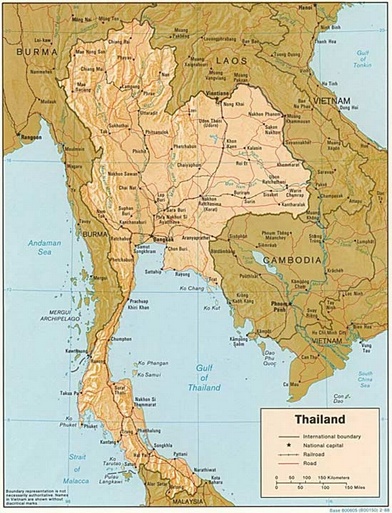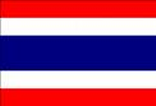





© Bart Everts

 |
 |
 |
 |
 |


| Northern Thailand offers great trekking oppurtunities through dramatic countryside. Of particular interest that these treks allow you to visit different hill-tribes which have made the mountains in Northern Thailand their home. We chose to do a trekking of two days in the Mae Teang area 1 hour north of Chiang Mai. Although we were told (how naive) this area was still quite of the beaten track, it was clearly not. During the 2 day trip we visited villages from 3 different hill tribes. This was a real disappointment, since these villages were tourist traps where the people only tried to sell you their handicrafts. Despite this, we could still appreciate the differences between the different tribes: from famous long-neck women (Paduang tribe, originally from Burma), and Lisu (also Burma), to the clearly more Chinese looking Hmong people (from Southern China). Furthermore, the combination of some elephant riding, Bamboo rafting (very relaxing) and white water rafting and some very beautiful walking through lush bamboo forests made it nonetheless an enjoyable trip. However, if we would visit this area a second time, we would opt for a more remote and longer trekking that will probably enable you to visit less spoilt hill-tribe villages. |

| Close to Lampang is one of the most authentic elephant training centers of Thailand: The Elephant Conservation Center. The center has a longstanding tradition in training wild Asian elephants to carry, push and pull logs in the timber industry in an animal friendly way (based on reward in stead of punishment). Of course there are shows in which they show their skills and there is the possibility to take a very enjoyable ride on their back for about half an hour. However, just as interesting are the factory where they make ecologically friendly paper from elephant dung and the only elephant hospital in the world where disabled elephants, due to for instance land mines, are treated and rehabilitated. We went there on a day trip van Chiang Mai and it is highly recommendable when you are even just a bit interested in these big friendly animals. |

| Chiang Mai is the tourist capital of the north and for good reason. The city itself is small enough to feel quickly acquainted, but also big enough to find everything you need. Chiang Mai harbours some very pretty temples of which the one on Doi Suthep, the mountain overlooking the city, is both in location and splendour, the most interesting one. Furthermore, for real shopaholics Chiang Mai is a shopping heaven with many markets, including the famous night markets. Moreover, lots of courses like Thai language, cooking and massage are available at virtually every street corner. With cheap food and accomodation it's a fantastic place to stay a longer time. In addition, Chiang Mai is also a perfect starting point for an exploration of the northern region: Elephant camps, orchid farms and beautiful national parks with pretty waterfalls are within 2 hours distance. We stayed for 6 days in a small hotel, Villa Oranje, with a very friendly staff, from where we made several trips to sites in and outside the city. |
 |
 |
| Physical activities: eg Walking / Rafting / swimming Nature: eg National Park / Reserve City / Cultural site |

 |
 |
 |
 |
 |
 |
 |
 |

| Doi Inthanon National Park is situated 100 kilometres south west of Chiang Mai and harbours the highest mountain of Thailand (2565m), where the park is named after. The park is famous for its plethora of waterfalls, beautiful mountain scenery and the possiblilty to reach the 'roof of Thailand' by car. Doi Inthanon temperate forests shelter a huge variety of flora and fauna. Particularly, bird life is very prolific: with 380 confirmed species it is one of the major birding destinations of South-East Asia. If you're not that much into birds it is still a pleasant and refreshing day trip from a hot and humid Chiang Mai. |

| Koh Samui is one of major island destinations in South-East Asia. Loads of tourists are attracted by its beautiful beaches fringed with coconot palms. The beaches on the east have seen most development with many big resorts. We have spent, however, a couple of days on a more quiet beach, Maenam, on the north side of the island. There we stayed in 'Harrry's Bungalows', which had nice bungalows, a decent swimming pool, and a good restaurant. We actually didn't see much of the island itself, since we went for 2 dyas to Koh Tao for scuba diving and on a daytrip to Ang Thong National Marine park, an archipel close to Koh Samui. |

| 200 kilometers north east of Bangkok is the first and one of the most famous national parks of Thailand. If you're a nature lover you have to visit this park. It is one of the best places in Asia to see Hornbilld and Gibbons in a huge stretch of unspoilt evergreen rainforest. In addition, the park still supports around 200 wild elephants, gaurs and even a couple of tigers. Many lodges in the vicinity of the park offer trips into the park by car. With a day trip organised by the Khao Yai Garden Lodge we spotted Sambar Deer, Muntjak, Jackal, Pig-tailed Macaque and White Handed Gibbon to name a few. In addition, during a night safari (driving around the park after sunset with a big search light) you might come across elephants. The park also boasts 300 or so species of bird. |

| This National park protects a group of uninhabited islands covered with rainforest west of Koh Samui. It can easily be visited on a organised daytrip from Koh Samui or Phangan. On such a tour you can kayak along the limestone cliffs of some of these islands, go snorkeling and visit a beautiful green colored lake. Although this trip was fun, you'll probably be better able to appriciate the beauty of this park when you stay overnight in one of the cabins on the main island. This allows you to explore the islands at your own pace and to have a chance to see the resident dusky langurs and long-tailed macaques. |

| The crowded capital of Thailand, Bangkok, is an interesting mixture of western modernity and traditional Thai lifestyle. One moment you're walking through little alleys where all kinds of local produce is being sold, while the next moment your standing in front of big shopping malls and skyscrapers. This is what I think, makes Bangkok so interesting. There's just something for everyone. The main tourist attractions are situated along the Chao Praya river: The beautiful Wat Phrae Keao, The holiest Buddhist temple complex in the country, it a must see. In combination with the Grand Palace it is one of the most beautiful and colurful examples of Thai art and architecture. Also Wat Pho, with its enormous reclining Buddha, and Wat Arun, which is the oldest Wat in town, are definately worth a visit. ALthough a little touristy, we can also recommend to take a longtail boat ride over the canals west of the main river, which gives you an idea what Bangkok must have been like a century ago. Also Chinatown is very enjoyable. Unfortunately however, one of the most obvious downsights of Bangkok is the abundancy of traffic: Everywehere are taffic jams and concommittant smog problems. Therefore, after a couple of days we were kind of glad to get out of this vibrant city to breath again some really fresh air. |

| Koh Tao is the best place for scuba diving in the Gulf of Thailand. On Curacao we got our PADI open water, so we planned to use it on Koh Tao for a couple of dives. We stayed one night on the beautiful Island 'triplet' of Koh Nangyuan: Just of the coast of Koh Tao are three small Islands that are interconnected by a narrow stretch of beach. A fantastic place! Around Nangyuan are many good places for snorkeling and not far away are couple of good dive sites. We visited Chumphon Pinnacles, famous for its reef sharks and occasional Manta Rays and even Whale Sharks. We saw Reef Sharks, barracudas, batfish, angelfish and many others. A very rewarding dive. Also 'twin peaks' was nice with beautiful corals, anemones and accessory anemone fish and clown fish. |

| Sukhothai, which is located somewhere halfway between Chiang Mai and Bangkok, was the capital of Siam in the 13th and 14th century. An impressive assembly of beautiful ruins is left from this former capital and is preserved as Sukhothai Historical Park. It is one ofThailand most visited ancient sites and is on the list of UNESCO world heritage sites. You can visit the park on a day trip from the new town of Sukhothai, 12 kilometres to the east, where lots of accomomdation is available. It is also possible to find accomodation in the historical park itself. Since the complex covers quite a big area, the best way to visit the ruins is by bike which can be rented at the entrance. |










 |